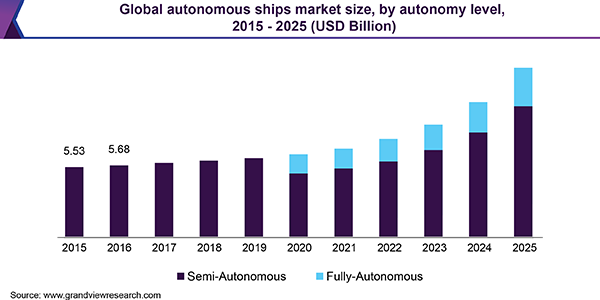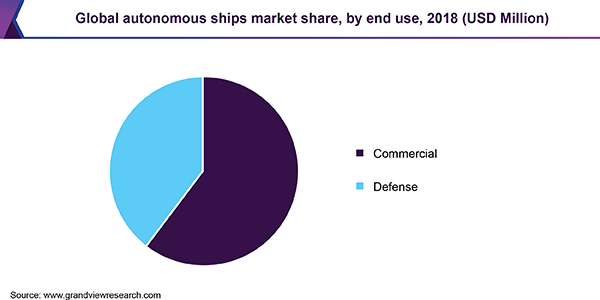- Home
- »
- Next Generation Technologies
- »
-
Autonomous Ships Market Size & Share, Industry Report, 2019-2025GVR Report cover
![Autonomous Ships Market Size, Share & Trends Report]()
Autonomous Ships Market Size, Share & Trends Analysis Report By Autonomy Level (Semi-Autonomous, Fully Autonomous), By Solutions (Systems & Software, Structures), By End Use, And Segment Forecasts, 2019 - 2025
- Report ID: GVR-3-68038-944-9
- Number of Report Pages: 80
- Format: PDF, Horizon Databook
- Historical Range: 2015 - 2017
- Forecast Period: 2019 - 2025
- Industry: Technology
Industry Insights
The global autonomous ships market size was valued at USD 6.03 billion in 2018 and is expected to register a CAGR of 13.5% over the forecast period. Growing seaborne trade across the globe coupled with increasing maritime tourism is anticipated to drive growth. Moreover, the lack of sailors is anticipated to drive the adoption of automated systems. These systems are installed in vessels to automate several processes, such as navigation and propulsion of the vessel, through the use of components and systems such as automated navigation systems, propulsion control systems, and sensors, among others. Most of these systems are already in use across various industries and applications such as aerospace and automobile. Maritime industry players are making huge financial investments to find the optimum way to combine these systems and technologies for the reliable and cost-effective functioning of unmanned vessels.
Cargo shipping has witnessed a tremendous rise over the years and as a result, creating momentum for commercial ships. These ships are used for transporting different goods to distant geographical locations, along with several crucial goods, such as oil and petroleum. Moreover, a rise in marine accidents caused by human errors leads to financial losses as well as harm to the marine ecosystem. For instance, as per the International Tanker Owners Pollution Federation, three large spills were amounting to more than 700 tonnes of oil and three medium spills ranging between 7 and 700 tonnes in 2018. Hence, governments across the globe have made stringent regulations about the pollution caused by such accidents. Autonomous vessels are expected to offer benefits including decreased accidental cases due to least or no human involvement in the fleet which is expected to positively influence the market growth.

Additionally, maritime trading is gaining traction worldwide which in turn requires a greater number of vessels to transport the freight. These vessels would require a huge number of seafarers for shipping operations. However, seagoing professions have witnessed a downfall due to the unattractive nature of the job. Additionally, a high degree of isolation is restricting the millennials to opt for such professions.
As a result, the marine industry is witnessing a lesser number of seafarers, thus, boosting the development of unmanned ships. Unmanned ships, on one hand, reduce the labor intensity of ship operation thereby reducing the pressure on the labor market for seafarers. On the other hand, as most of the on-board tasks would be automated, only navigational and technical tasks would be left for manual operations that will be transferred from ship to shoreside operations. Hence, making seafaring jobs more family-friendly and more attractive than today.
As the number of applications of robotics and Artificial intelligence (AI) is growing, the time is not far when the Internet of Things (IoT) would be integrated seamlessly across every industry and sector. For promoting autonomous vehicles around the globe, the One Sea Ecosystem was founded in 2016 by the top players in the marine and IT industry including ABB, Rolls-Royce, Wärtsilä, and Tieto. The One Sea -Autonomous Marine Ecosystem is developing roadmap to an autonomous maritime future, including the levels of autonomy and a timeline toward 2025. It primarily focuses on making efforts to minimize accidents, reduce the environmental footprint of maritime traffic, and improve the efficiency of autonomous marine ventures. The rising attempts to develop an autonomous maritime ecosystem are expected to bolster the growth in demand for unmanned vessels in near future.
Autonomy Level Insights
On the basis of autonomy level, the autonomous ships market has been segmented into semi- and fully autonomous. Since fully autonomous ships are expected to be commercialized by 2020, the market sales have been majorly driven by semi-autonomous ships. These ships have pre-installed components and systems such as sensors and navigation systems. Additionally, these systems can also be installed in old vessels that have complete manual operations.
However, fully autonomous ship segment is expected to account for a considerable market share by 2025 due to the unparalleled benefits that these vessels will offer as compared to the semi-autonomous ships. These benefits include risk mitigation of the transport, reduction in human errors, and efficient utilization of ship space. Advanced maneuvering and navigation systems that use GPS and sensors would enable efficient ship transportation without involving human intervention. Furthermore, the reduced operating cost and faster operations that fully autonomous ships will provide are expected to propel the segment growth over the forecast period.
Solutions Insights
The solutions segment has been bifurcated into systems and software and structures. The systems and software segment held the dominant market share in 2018, owing to the increasing implementation of automated systems in vessels that have already been manufactured. Additionally, some of the systems including sensors, autonomous navigation systems such as Collision Avoidance (CA) system, Dynamic Positioning (DP) system, Route Planning (RP), and Situational Awareness (SA) system, are being installed in the newly build vessels for automating one or several processes of the ship. This factor is anticipated to bode well for the segment growth.
The fully automated ship structures are still in the R&D phase before the actual commercial operation that is expected to begin by 2020. However, autonomous ship structures are expected to witness the fastest growth over the forecast period. These structures are expected to have in-built autonomous systems that would be installed during shipbuilding. The fully autonomous ship structures will have more cargo space as they would not require space for sailors. Increased cargo space coupled with the elimination of crew which in turn will reduce the personnel and auxiliary cost incurred for on-board provisions on the voyage, is expected to propel the segment growth in the forthcoming years.
End-use Insights
The commercial segment dominated the market in 2018. Increasing cargo shipments drive the need for vessels and more sailors, increasing the operation costs, which is expected to fuel the adoption of automated systems in commercial vessels. These systems reduce the operating cost and provide more space for the cargo, which is expected to spur the segment growth in the forthcoming years.

Although unmanned ships are planned and designed to operate without or with the least human intervention, the possible damage caused by these vessels could be unimaginable. In defense applications, these systems create the risk of exploitation by hackers, criminals, terrorists, and other such adversaries. As these ships depend on the electromagnetic spectrum along with cyberspace infrastructure, the lack of onboard human responders could provide an opportunity for adversaries to interfere with these vessels and use them as a weapon. Hence, the deployment of fully-autonomous ships in the defense sector is expected to witness slow growth over the forecast period.
Regional Insights
In terms of revenue, Asia Pacific dominated the market in 2018 and is anticipated to continue its dominance over the forecast period. The higher share of this region can be attributed to the countries such as China which are some of the top shipping nations in the world. China holds a very strong market position with the largest bulk and container ports. Sea trade accounts for more than 60% of China’s total trade which is anticipated to increase the demand for commercial vessels in the country, thereby contributing to the regional market growth.
Europe is anticipated to witness the fastest CAGR over the forecast period owing to the increasing demand for cruise ships as well as autonomous ships in the region. Additionally, Europe has the highest number of shipowners in the world. Increasing adoption of autonomous systems and components to be retrofitted in the existing ships by these ship owners is contributing to the regional growth. Moreover, rapid technological advancements coupled with an increasing trend toward the adoption of automated systems are expected to spur the regional market growth over the forecast period.
Autonomous Ships Market Share Insights
Prominent market players include ABB, Rolls-Royce, Wartsila, Kongsberg Gruppen, Rh Marine, L3 ASV, and Siemens. These market players are focusing on various business strategies to gain a higher market share. These players engage in partnerships, mergers and acquisitions, and contractual agreements to gain greater market share. Moreover, several big players are testing fully autonomous vessels, which is expected to transform the entire shipping industry. For instance, in December 2017, Rolls-Royce and Mitsui O.S.K. Lines announced to enter into a deal for joint research on an advisory-type Intelligent Awareness System (IAS) that would detect obstacles near vessels with advanced sensors and provide instantaneous operational support information to the onboard personnel.
Report Scope
Attribute
Details
Base year for estimation
2018
Actual estimates/Historical data
2015 - 2017
Forecast period
2019 - 2025
Market representation
Revenue in USD Million and CAGR from 2019 to 2025
Regional scope
North America, Europe, Asia Pacific, Latin America, and MEA
Country scope
U.S., Canada, U.K., Germany, France, China, India, Japan, Brazil, and Mexico
Report coverage
Revenue forecast, company share, competitive landscape, growth factors, and trends
15% free customization scope (equivalent to 5 analysts working days)
If you need specific information which is not currently within the scope of the report, we will provide it to you as a part of the customization
Segments Covered in the ReportThis report forecasts revenue growth at global, regional, and country levels and provides an analysis of the latest industry trends in each of the sub-segments from 2015 to 2025. For the purpose of this study, Grand View Research has segmented the global autonomous ships market report on the basis of autonomy level, solutions, end-use, and region:
-
Autonomy Level Outlook (Revenue, USD Million, 2015 - 2025)
-
Semi-autonomous
-
Fully Autonomous
-
-
Solutions Outlook (Revenue, USD Million, 2015 - 2025)
-
Systems & Software
-
Structure
-
-
End-use Outlook (Revenue, USD Million, 2015 - 2025)
-
Commercial
-
Passenger Cruise
-
Bulk Carrier & Container Ships
-
Tankers
-
Others
-
-
Defense
-
Submarines
-
Aircraft Carriers
-
Destroyers
-
Frigates
-
-
-
Regional Outlook (Revenue, USD Million, 2015 - 2025)
-
North America
-
The U.S.
-
Canada
-
-
Europe
-
The U.K.
-
Germany
-
France
-
-
Asia Pacific
-
China
-
India
-
Japan
-
-
Latin America
-
Brazil
-
Mexico
-
-
Middle East & Africa
-
Share this report with your colleague or friend.
![gvr icn]()
NEED A CUSTOM REPORT?
We can customize every report - free of charge - including purchasing stand-alone sections or country-level reports, as well as offer affordable discounts for start-ups & universities. Contact us now
![Certified Icon]()
We are GDPR and CCPA compliant! Your transaction & personal information is safe and secure. For more details, please read our privacy policy.
We are committed towards customer satisfaction, and quality service.
"The quality of research they have done for us has been excellent."





